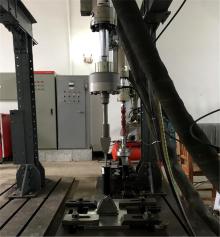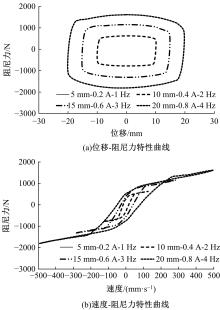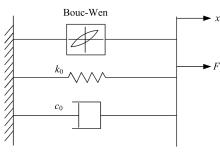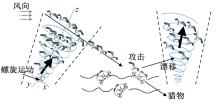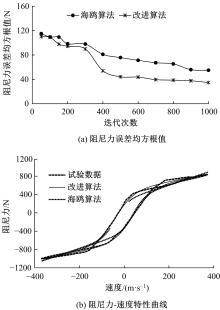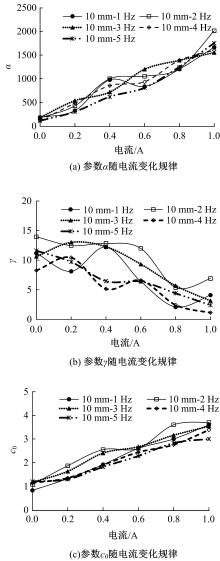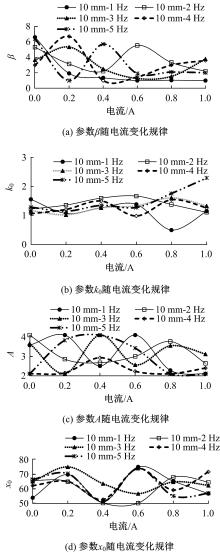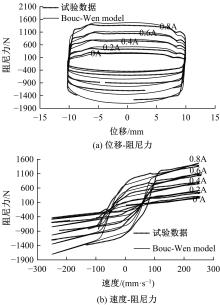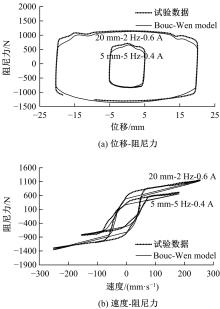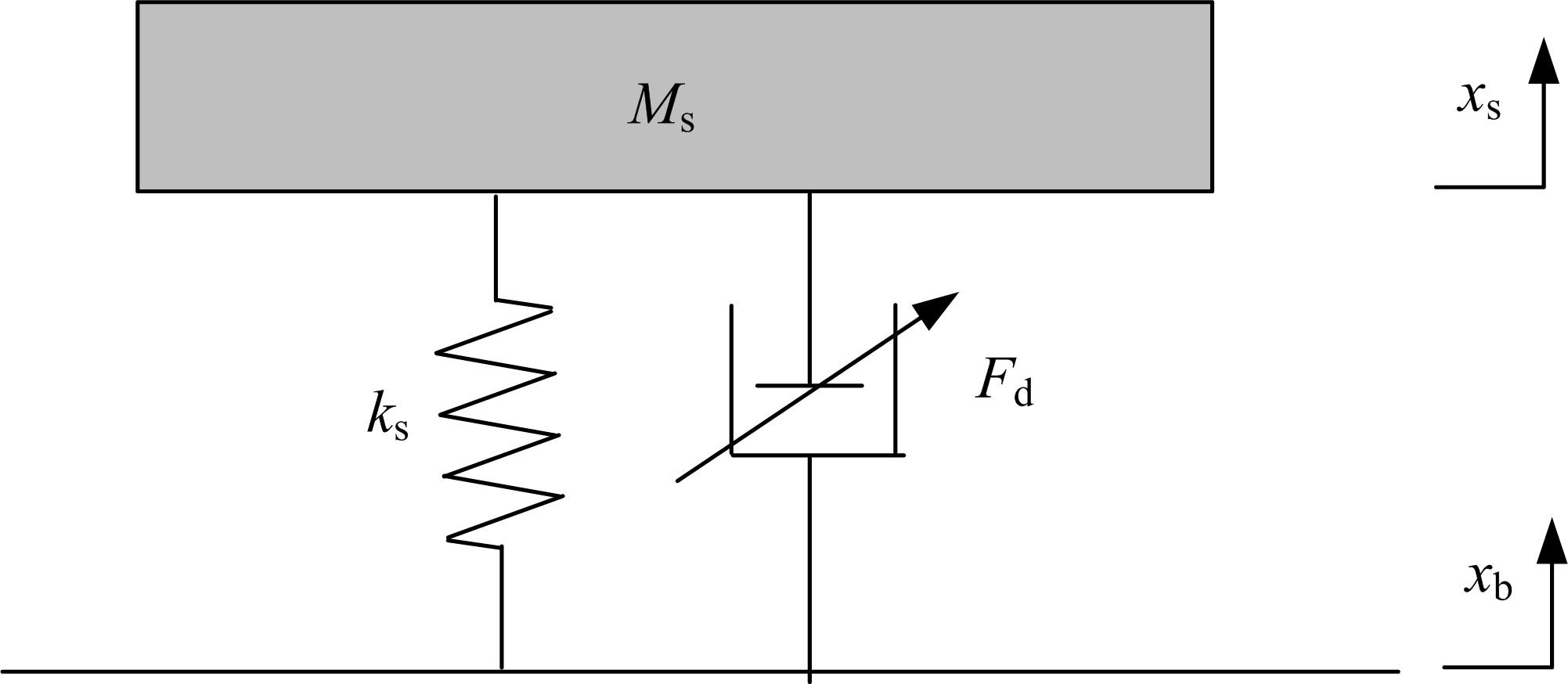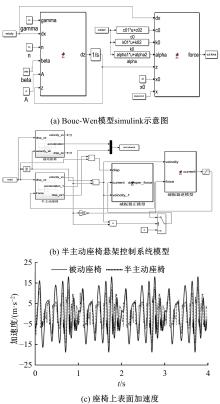Journal of Jilin University(Engineering and Technology Edition) ›› 2022, Vol. 52 ›› Issue (4): 764-772.doi: 10.13229/j.cnki.jdxbgxb20200887
Parameter identification of magnetorheological damper model with modified seagull optimization algorithm
Wen-ku SHI( ),Shu-guang ZHANG,You-kun ZHANG(
),Shu-guang ZHANG,You-kun ZHANG( ),Zhi-yong CHEN,Yi-fei JIANG,Bin-bin LIN
),Zhi-yong CHEN,Yi-fei JIANG,Bin-bin LIN
- State Key Laboratory of Automotive Simulation and Control,Jilin University,Changchun 130022,China
CLC Number:
- U461.4
| 1 | Zong L H, Gong X L, Xuan S H, et al. Semi-active H infinity control of high-speed railway vehicle suspension with magnetorheological dampers[J]. Vehicle System Dynamics, 2013, 51(5): 600-626. |
| 2 | Mai V N, Yoon D S, Choi S B, et al. Explicit model predictive control of semi-active suspension systems with magneto-rheological dampers subject to input constraints[J]. Journal of Intelligent Material Systems and Structures, 2020, 31(10): 1157-1170. |
| 3 | Du X M, Yu M, Fu J, et al. Experimental study on shock control of a vehicle semi-active suspension with magneto-rheological damper[J]. Smart Materials and Structures, 2020, 29(7): No.074002. |
| 4 | Phu D X, Shin D K, Choi S B. Design of a new adaptive fuzzy controller and its application to vibration control of a vehicle seat installed with an MR damper[J]. Smart Materials and Structures, 2015, 24(8): No. 085012. |
| 5 | Bai X X, Chen P, Qian L J. Principle and validation of modified hysteretic models for magnetorheological dampers[J]. Smart Materials and Structures, 2015, 24(8): No. 085014. |
| 6 | Wang W X, Hua X G, Wang X Y, et al. Mechanical behavior of magnetorheological dampers after long-term operation in a cable vibration control system[J]. Structural Control and Health Monitoring, 2019, 26(1): No.e2280. |
| 7 | Zhang C, Wang L X. Dynamic models for magnetorheological dampers and its feedback linearization[J]. Advanced Materials Research, 2009, 79-82: 1205-1208. |
| 8 | 左曙光, 毛钰, 吴旭东, 等. 磁流变减振器高频硬化特性建模及优化[J]. 振动与冲击, 2016, 35(10): 120-125, 150. |
| Zuo Shu-guang, Mao Yu, Wu Xu-dong, et al. Modelling and optimization of high frequency hardening characteristics of magneto rheological damper [J]. Journal of Vibration and Shock, 2016, 35(10): 120-125, 150. | |
| 9 | 彭虎, 张进秋, 刘义乐, 等. 基于改进双Sigmoid模型的磁流变减振器力学建模研究[J].振动与冲击, 2019, 38(15): 216-222. |
| Peng Hu, Zhang Jin-qiu, Liu Yi-le,et al. MR damper's modeling based on improved dual-sigmoid model [J]. Journal of Vibration and Shock, 2019, 38(15): 216-222. | |
| 10 | 薛兵, 杜永昌, 刘源, 等. 基于机理的磁流变减震器滞回特性魔术公式模型[J]. 振动工程学报, 2017, 30(5): 774-780. |
| Xue Bing, Du Yong-chang, Liu Yuan, et al. Magic formula model of hysteresis characteristics of magnetorheological damper based on mechanism[J]. Journal of Vibration and Shock, 2017, 30(5): 774-780. | |
| 11 | Charalampakis A E, Koumousis V K. Identification of bouc–wen hysteretic systems by a hybrid evolutionary algorithm[J]. Journal of Sound and Vibration, 2008, 314(3-5): 571-585. |
| 12 | Kwok N M, Ha Q P, Nguyen T H, et al. A novel hysteretic model for magnetorheological fluid dampers and parameter identification using particle swarm optimization[J]. Sensors and Actuators A: Physical, 2006, 132(2): 441-451. |
| 13 | 郑玲, 牛伯瑶, 李以农, 等. 基于遗传算法的汽车磁流变减振器多目标优化[J]. 汽车工程, 2016, 38(7): 871-877. |
| Zheng Ling, Niu Bo-yao, Li Yi-nong, et al. Multi-objective optimization of vehicle MR damper based on genetic algorithm[J]. Automotive Engineering, 2016, 38(7): 871-877. | |
| 14 | 刘永强, 杨绍普, 廖英英. 一种磁流变减震器模型参数识别新方法[J]. 机械工程学报, 2018, 54(6): 62-68. |
| Liu Yong-qiang, Yang Shao-pu, Liao Ying-ying. A new method of parameters identification for magnetorheological damper model[J]. Journal of Mechanical Engineering, 2018, 54(6): 62-68. | |
| 15 | Zeinali M, Mazlan S A, Fatah A Y A, et al. A phenomenological dynamic model of a magnetorheological damper using a neuro-fuzzy system[J]. Smart Materials and Structures, 2013, 22(12): No. 125013. |
| 16 | 王戡, 郑玲, 刘非. 基于广义回归神经网络的磁流变减振器模型辨识[J]. 汽车工程, 2013, 35(7): 619-623, 634. |
| Wang Kan, Zheng Ling, Liu Fei. Model identification of mr damper based on generalized regression neural network[J]. Automotive Engineering, 2013, 35(7): 619-623, 634. | |
| 17 | Spencer B F, Dyke S J. Phenomenological model for magnetorheological dampers[J]. Journal of Engineering Mechanics, 1997, 123(3): 230-237. |
| 18 | Dhiman G, Kumar V. Seagull optimization algorithm: theory and its applications for large-scale industrial engineering problems[J]. Knowledge-Based Systems, 2019, 165: 169-196. |
| 19 | Cao Y, Li Y Q, Zhang G, et al. Experimental modeling of PEM fuel cells using a new improved seagull optimization algorithm[J]. Energy Reports, 2019, 5: 1616-1625. |
| 20 | 喻飞,李元香,魏波, 等.透镜成像反学习策略在粒子群算法中的应用[J]. 电子学报, 2014, 42(2): 230-235. |
| Yu Fei, Li Yuan-xiang, Wei Bo, et al. The application of a novel obl based on lens imaging principle in PSO[J]. Acta Electronica Sinica, 2014, 42(2): 230-235. |
| [1] | Jie LI,Tao CHEN,Wen-cui GUO,Qi ZHAO. Pseudo excitation method of vehicle non-stationary random vibration in space domain and its application [J]. Journal of Jilin University(Engineering and Technology Edition), 2022, 52(4): 738-744. |
| [2] | Ying-chao ZHANG,Yun-hang LI,Zi-yu GUO,Guo-hua WANG,Zhe ZHANG,Chang SU. Optimization of the aerodynamic drag reduction of a cab behind engine vehicle [J]. Journal of Jilin University(Engineering and Technology Edition), 2022, 52(4): 745-753. |
| [3] | Liang DUAN,Chun-yuan SONG,Chao LIU,Wei WEI,Cheng-ji LYU. State recognition in bearing temperature of high-speed train based on machine learning algorithms [J]. Journal of Jilin University(Engineering and Technology Edition), 2022, 52(1): 53-62. |
| [4] | Wei-min ZHUANG,Shen CHEN,Nan WANG. Influence on thermal stress of autobody steel-aluminum clinch-adhesive connection structure [J]. Journal of Jilin University(Engineering and Technology Edition), 2022, 52(1): 70-78. |
| [5] | Jian-bin CHEN,Song-ze ZHOU,Feng-yong FEI,Yong-long CHEN,Guo-ping LING. Influences of interference fit and knurling connection type on press fitting failure of assembled camshaft [J]. Journal of Jilin University(Engineering and Technology Edition), 2021, 51(6): 1959-1966. |
| [6] | Xing-jun HU,Jing-long ZHANG,Yu-fei LUO,Li XIN,Sheng LI,Jin-rui HU,Wei LAN. Influence investigation of cooling tube structure and airflow direction on thermal⁃hydraulic performance of air⁃cooled charge air cooler [J]. Journal of Jilin University(Engineering and Technology Edition), 2021, 51(6): 1933-1942. |
| [7] | Yong LUO,Yong-heng WEI,Huan HUANG,Ren-jie XIAO,Lin REN,Huan-yu CUI. Starting control of P2.5 plug⁃in hybrid configuration dual⁃clutch based on driver's intention recognition [J]. Journal of Jilin University(Engineering and Technology Edition), 2021, 51(5): 1575-1582. |
| [8] | Xiao-hua ZENG,Mei-jie SONG,Da-feng SONG,Yue WANG. Data processing method of bus driving cycle based on vehicular network information [J]. Journal of Jilin University(Engineering and Technology Edition), 2021, 51(5): 1692-1699. |
| [9] | Chao MA,Yun-kai GAO,Zhe LIU,Yue-xing DUAN,Lin-li TIAN. Optimization of multi⁃material and beam cross⁃sectional shape and dimension of skeleton⁃type body [J]. Journal of Jilin University(Engineering and Technology Edition), 2021, 51(5): 1583-1592. |
| [10] | Feng-chong LAN,Ji-wen LI,Ji-qing CHEN. DG-SLAM algorithm for dynamic scene compound deep learning and parallel computing [J]. Journal of Jilin University(Engineering and Technology Edition), 2021, 51(4): 1437-1446. |
| [11] | Jian YANG,Qi XIA,Hai-chao ZHOU,Guo-lin WANG. Noise reduction mechanism of truck radial tire based on modified carcass string contour design [J]. Journal of Jilin University(Engineering and Technology Edition), 2021, 51(4): 1198-1203. |
| [12] | Jiang-qi LONG,Jin-tao XIANG,Ping YU,Jun-cheng WANG. Linear disturbance observer suitable for sliding mode control of nonlinear active suspension [J]. Journal of Jilin University(Engineering and Technology Edition), 2021, 51(4): 1230-1240. |
| [13] | Xin CHEN,Gui-shen YU,Biao ZHANG,Kai-xuan PAN,Li-fei YANG. Equivalent modeling of tensile-shear behavior for friction stir spot welding joints [J]. Journal of Jilin University(Engineering and Technology Edition), 2021, 51(4): 1190-1197. |
| [14] | Da-feng SONG,Li-li YANG,Xiao-hua ZENG,Xing-qi WANG,Wei-zhi LIANG,Nan-nan YANG. Battery life optimization of hybrid electric vehicle based on driving cycle construction [J]. Journal of Jilin University(Engineering and Technology Edition), 2021, 51(3): 781-791. |
| [15] | Ren HE,Xiao-cong ZHAO,Yi-bin YANG,Jian-qiang WANG. Man⁃machine shared driving model using risk⁃response mechanism of human driver [J]. Journal of Jilin University(Engineering and Technology Edition), 2021, 51(3): 799-809. |
|
||
